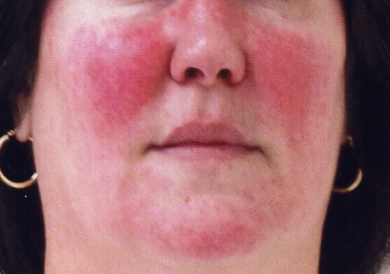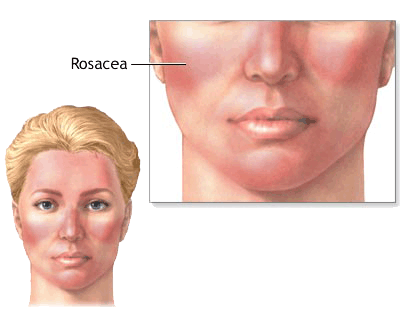 |
||||||
|
|
||||||
|
Rosacea
Although rosacea can affect all segments of the population, individuals with fair skin who tend to flush or blush easily are believed to be at greatest risk. The disease is more frequently diagnosed in women, but more severe symptoms tend to be seen in men -- perhaps because they often delay seeking medical help until the disorder reaches advanced stages. What Should I Look For? Rosacea can vary substantially from one individual to another, and in most cases some rather than all of the potential signs and symptoms appear. According to a consensus committee and review panel of 17 medical experts worldwide (see Classification of Rosacea), rosacea always includes at least one of the following primary signs, and various secondary signs and symptoms may also develop. Primary Signs of Rosacea
Many people with rosacea have a history of frequent blushing or flushing. This facial redness may come and go, and is often the earliest sign of the disorder.
Persistent facial redness is the most common individual sign of rosacea, and may resemble a blush or sunburn that does not go away.
Small red solid bumps or pus-filled pimples often develop. While these may resemble acne, blackheads are absent and burning or stinging may occur.
In many people with rosacea, small blood vessels become visible on the skin.
Other Potential Signs and Symptoms
In many people with rosacea, the eyes may be irritated and appear watery or bloodshot, a condition known as ocular rosacea. The eyelids also may become red and swollen, and styes are common. Severe cases can result in corneal damage and vision loss without medical help.
Burning or stinging sensations may often occur on the face. Itching or a feeling of tightness may also develop.
The central facial skin may be rough, and thus appear to be very dry.
Raised red patches, known as plaques, may develop without changes in the surrounding skin.
The skin may thicken and enlarge from excess tissue, most commonly on the nose. This condition, known as rhinophyma, affects more men than women.
Facial swelling, known as edema, may accompany other signs of rosacea or occur independently.
Rosacea signs and symptoms may also develop beyond the face, most commonly on the neck, chest, scalp or ears.
|
The facts aboout rosacea:
|
| Content copyright © . Striking Skin by Tanya. All rights reserved. |
 Rosacea is a chronic and potentially life-disruptive disorder primarily of the facial skin, often characterized by flare-ups and remissions. Many have observed that it typically begins any time after age 30 as a redness on the cheeks, nose, chin or forehead that may come and go. In some cases, rosacea may also occur on the neck, chest, scalp or ears. Over time, the redness tends to become ruddier and more persistent, and visible blood vessels may appear. Left untreated, bumps and pimples often develop, and in severe cases the nose may grow swollen and bumpy from excess tissue. This is the condition, called rhinophyma, that gave the late comedian W.C. Fields his trademark bulbous nose. In many rosacea patients, the eyes are also affected, feeling irritated and appearing watery or bloodshot.
Rosacea is a chronic and potentially life-disruptive disorder primarily of the facial skin, often characterized by flare-ups and remissions. Many have observed that it typically begins any time after age 30 as a redness on the cheeks, nose, chin or forehead that may come and go. In some cases, rosacea may also occur on the neck, chest, scalp or ears. Over time, the redness tends to become ruddier and more persistent, and visible blood vessels may appear. Left untreated, bumps and pimples often develop, and in severe cases the nose may grow swollen and bumpy from excess tissue. This is the condition, called rhinophyma, that gave the late comedian W.C. Fields his trademark bulbous nose. In many rosacea patients, the eyes are also affected, feeling irritated and appearing watery or bloodshot.
